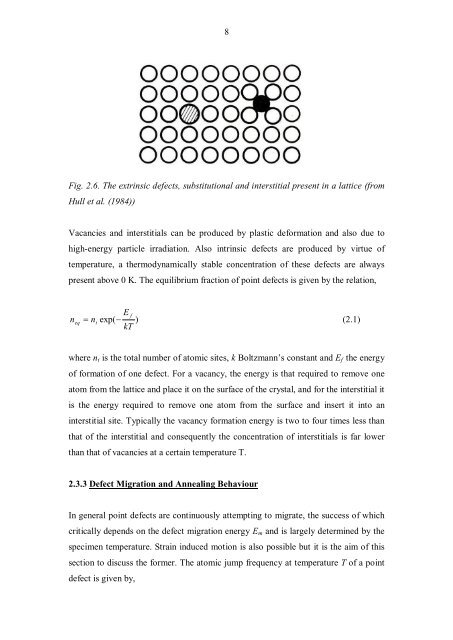Analysis of the extended defects in 3C-SiC.pdf - Nelson Mandela ...
Analysis of the extended defects in 3C-SiC.pdf - Nelson Mandela ...
Analysis of the extended defects in 3C-SiC.pdf - Nelson Mandela ...
You also want an ePaper? Increase the reach of your titles
YUMPU automatically turns print PDFs into web optimized ePapers that Google loves.
8<br />
Fig. 2.6. The extr<strong>in</strong>sic <strong>defects</strong>, substitutional and <strong>in</strong>terstitial present <strong>in</strong> a lattice (from<br />
Hull et al. (1984))<br />
Vacancies and <strong>in</strong>terstitials can be produced by plastic deformation and also due to<br />
high-energy particle irradiation. Also <strong>in</strong>tr<strong>in</strong>sic <strong>defects</strong> are produced by virtue <strong>of</strong><br />
temperature, a <strong>the</strong>rmodynamically stable concentration <strong>of</strong> <strong>the</strong>se <strong>defects</strong> are always<br />
present above 0 K. The equilibrium fraction <strong>of</strong> po<strong>in</strong>t <strong>defects</strong> is given by <strong>the</strong> relation,<br />
n<br />
eq<br />
E f<br />
nt<br />
exp( )<br />
(2.1)<br />
kT<br />
where nt is <strong>the</strong> total number <strong>of</strong> atomic sites, k Boltzmann’s constant and Ef <strong>the</strong> energy<br />
<strong>of</strong> formation <strong>of</strong> one defect. For a vacancy, <strong>the</strong> energy is that required to remove one<br />
atom from <strong>the</strong> lattice and place it on <strong>the</strong> surface <strong>of</strong> <strong>the</strong> crystal, and for <strong>the</strong> <strong>in</strong>terstitial it<br />
is <strong>the</strong> energy required to remove one atom from <strong>the</strong> surface and <strong>in</strong>sert it <strong>in</strong>to an<br />
<strong>in</strong>terstitial site. Typically <strong>the</strong> vacancy formation energy is two to four times less than<br />
that <strong>of</strong> <strong>the</strong> <strong>in</strong>terstitial and consequently <strong>the</strong> concentration <strong>of</strong> <strong>in</strong>terstitials is far lower<br />
than that <strong>of</strong> vacancies at a certa<strong>in</strong> temperature T.<br />
2.3.3 Defect Migration and Anneal<strong>in</strong>g Behaviour<br />
In general po<strong>in</strong>t <strong>defects</strong> are cont<strong>in</strong>uously attempt<strong>in</strong>g to migrate, <strong>the</strong> success <strong>of</strong> which<br />
critically depends on <strong>the</strong> defect migration energy Em and is largely determ<strong>in</strong>ed by <strong>the</strong><br />
specimen temperature. Stra<strong>in</strong> <strong>in</strong>duced motion is also possible but it is <strong>the</strong> aim <strong>of</strong> this<br />
section to discuss <strong>the</strong> former. The atomic jump frequency at temperature T <strong>of</strong> a po<strong>in</strong>t<br />
defect is given by,

















